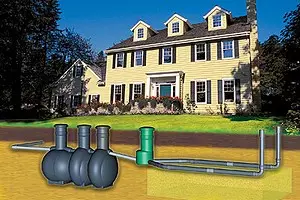
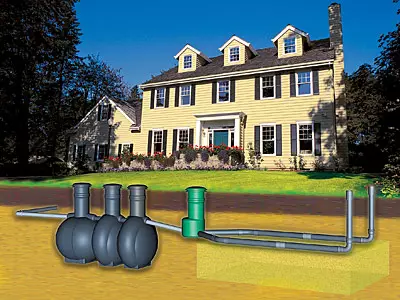
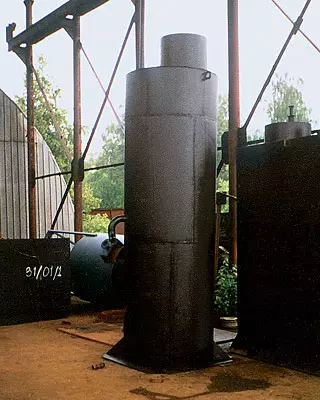
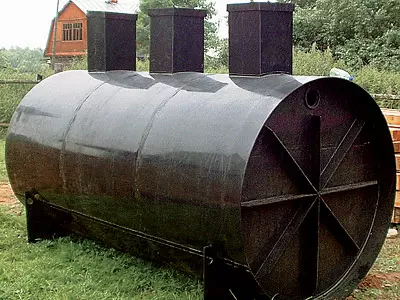
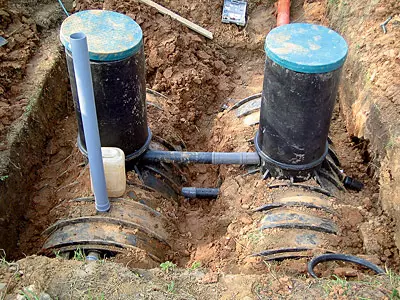
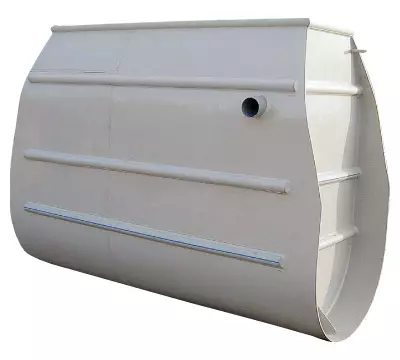
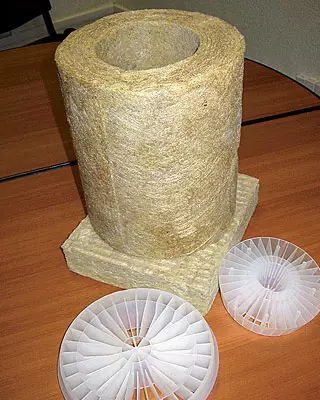
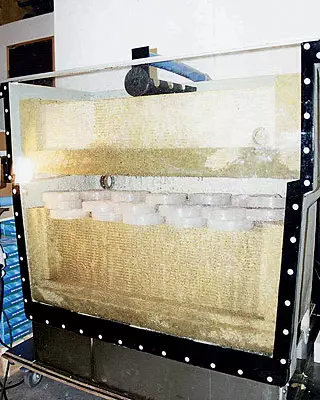
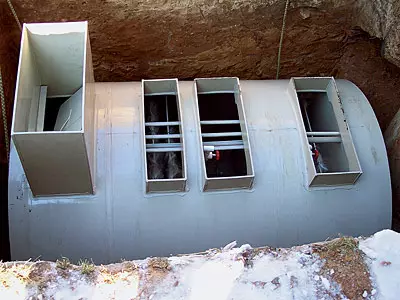
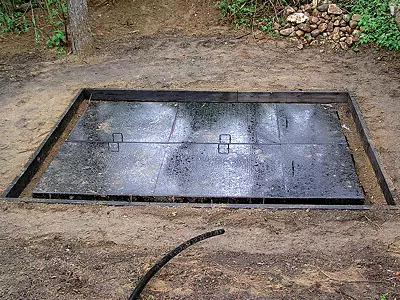
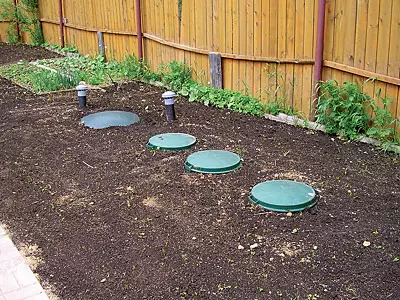
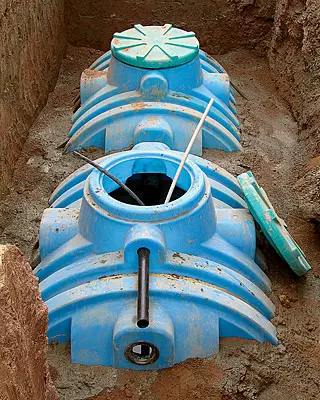
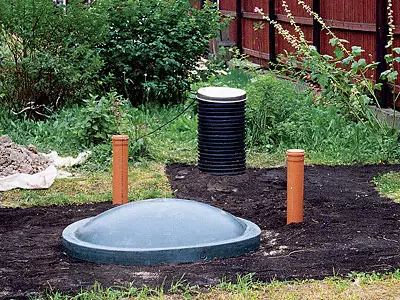
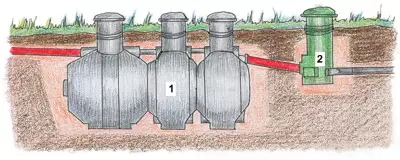
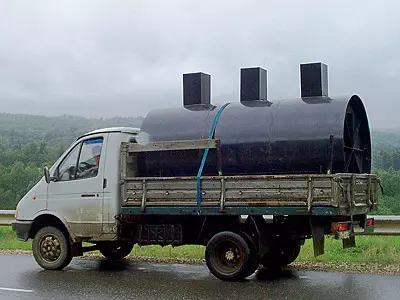
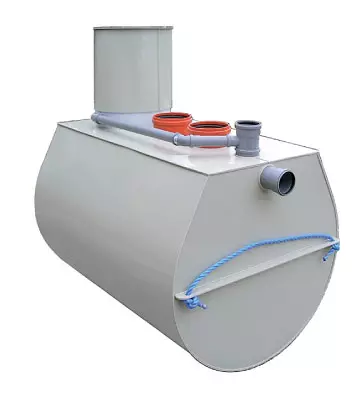
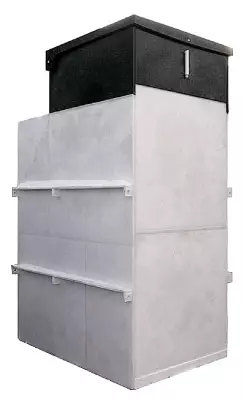
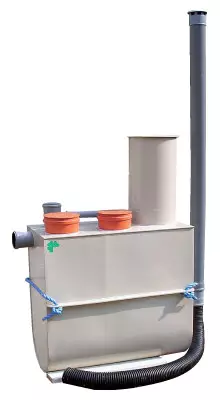
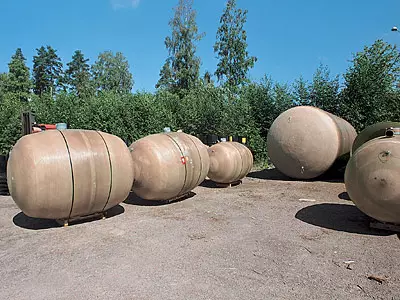
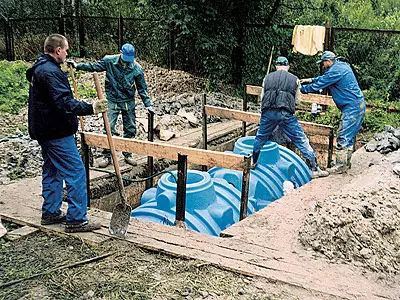
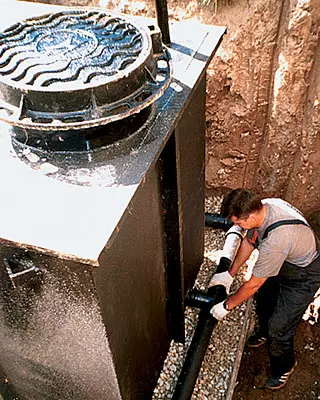
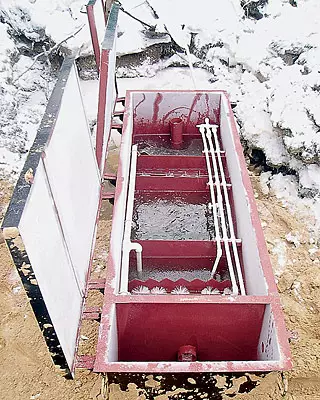
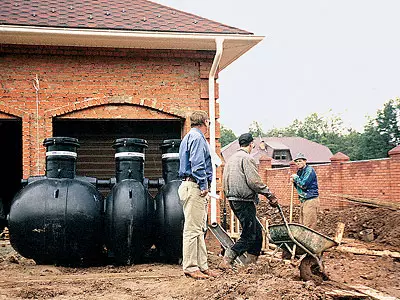
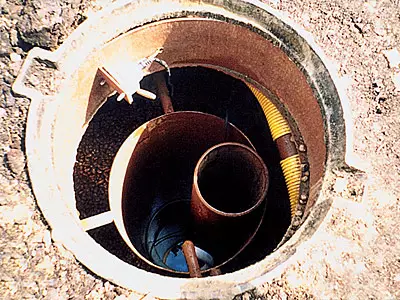
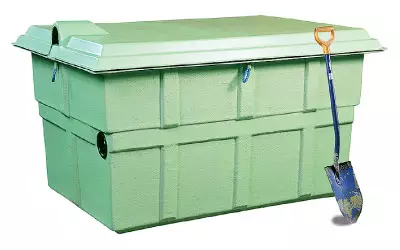
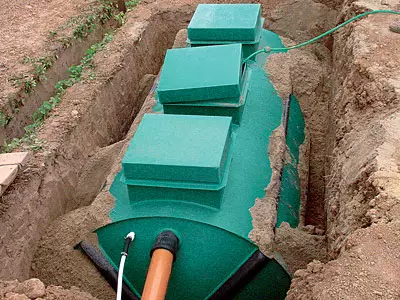
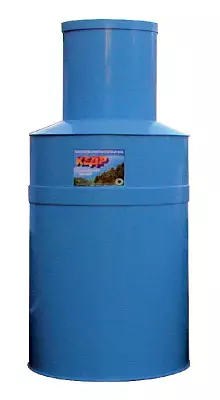
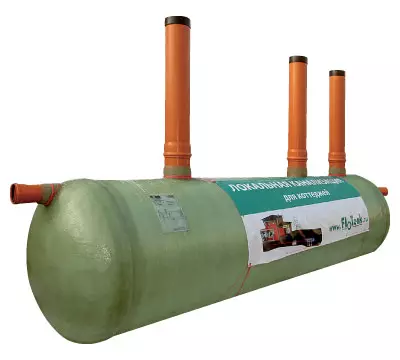
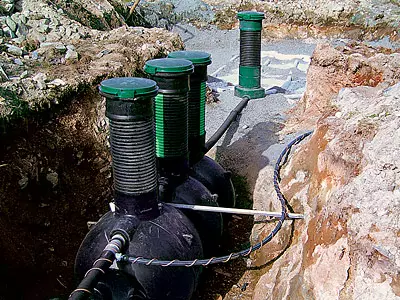
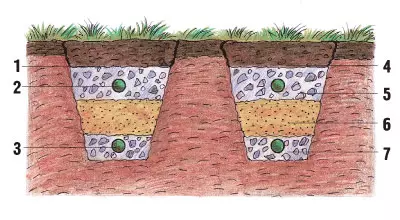
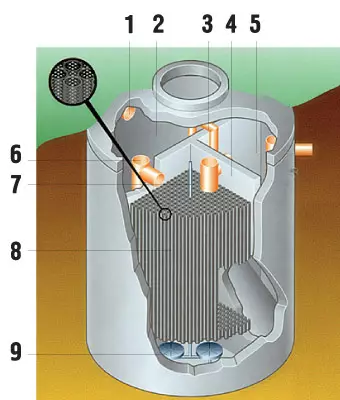
1. Caulsive input 2. Purpose Sustainer 3. Return of the active ral 4.Arisable biofilter 5.Torphic sump 6.Erlift of the supply of wastewater 7. The supply of air supply 8.Forge from the stabilized PND 9.Aerator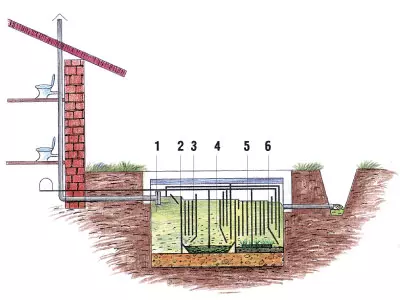
1.Septic 2.Boreactor 3.Aerotenk of the first stage 4.Torpete sump 5.Aerotenk second stage 6.Tretic sump
The editors thanks the company Uponor, Green Rock Oy, "Elitstroyinvest", "Engineering equipment", "Elgad Polymer", "VodtakhService", "Locas", "Cubost", "Country Unit", "Albatross", "Sweet-floor", "Energotech" for help in the preparation of material.
One of the conditions for the delivery of a country house to operate is the presence of a wastewater treatment system that meets the requirements of SanPiN. The owners of small garden houses can, of course, all "amenities" place in the yard and restrict ourselves to a cesspool, but the owners of the cottages under construction will inevitably have to look for a more appropriate option.
Today, a lot of systems for wastewater treatment are represented in the Russian market. The designs of different firms differ from each other with material manufacturing, performance, dimensions, features of service, the price of the IDR. The same work of any of them is built in the same principle: the device flows the sewage drains, clean, and then purified water enters the ground or relief. In effectly from the scheme used, all wastewater treatment systems can be divided into two types: structures with underground flow filtration and the installation of biological purification.
Devices with underground filtering
Such devices include septic tank and underground filtering system. On the basis of septics, you can mount the local sewage network for individual houses. Septicism is a structure for accumulation and pre-purification of a small amount (up to 25m3 per day) of household wastewater. Septics are underground sumps, horizontal or vertical, cylindrical or rectangular consisting of one or more cameras through which the drains flow. Cleaning is carried out in them as follows. Waste waters containing fecal and organic contaminants, from the home sewage release, first fall into the outer pipeline, and then to the septic tank. For the processes occurring in the septic, they do not need oxygen and sunlight, as there are anaerobic microorganisms in the drains. Weighted, dissolved and colloidal substances in wastewater, under the influence of rotary bacteria, are converted into an active il, settlement at the bottom of the septic. During the decomposition of the organic, gases are formed, thanks to which the contents of the tank resides in a constant motion: particles of il are fond of gas bubbles up. At the same time, the upper layers of the drains are infected with anaerobic bacteria. Away gas bubbles are bursting, particles of ilas are again settled on the bottom, creating a stock of food for bacteria and supporting the process of fermenting new portions of contaminants. Because the decomposition is accompanied by the release of gases, it is necessary to provide ventilation with the output of the exhaust part to the roof of the house.
The decomposition process proceeds quite slowly: for the final fermentation of the seafding mixture and the sediment requires 1.5-2 months. But this is in theory, and in practice are usually limited to the minimum period of finding wastewater in septic (3 days). In this case, only partial decomposition of the organic occurs, because small volume septic tanks are mainly used to remove suspended substances.
After the passage of the effluent through the chambers, the septicity of the water is separated by the precipitate and settles on the bottom, and the clarified liquid needs to clean. (The prepaid is carried out naturally in the structures of underground filtering, which we will tell a little later.) The effect of cleaning in septic on the organic agent is 30-35%, on suspended substances - 60-65%. That is, this type of devices captures only a small part of organic contaminants, in the bulk of which are soluble. The undisputed fractions remaining at the bottom of the septicity, it is necessary to remove with the assessing machine; Call it, as practice shows, accounts for 1-2 times a year. This service is from $ 30 to $ 100. However, it is impossible to solve all IL, it should be left 10-20% in order not to deprive the fermentation process of "swarms" - microorganisms living in sediment.
Septic typing can be bought in the finished version or mount yourself. In the Russian septicki market are presented as models of foreign manufacturers: Uponor Sako from Uponor, Labko Sako-3 Twin from Labko (Finland) and domestic: "Cedar" ("Kontur-West"), Purflo ("Sweet-floor"), "DSC-mini" ("Cate sewer systems"), "cubation-1" ("cubation"), "breeze-1" ("ELGAD POLYMER"), "with 1 zhbm" ("Water Mervice"), "Ilet" ("Albatross"), "etco" ("etco"). The cost of septic is from $ 400 to $ 2945.

Marketing Communications Manager CJSC Uzonor Rus:
"The soil cleaning systems are convenient and easy to use, non-volatile and are ideal for seasonal accommodation. It is very important to properly exploit the system. Upon the condition of seasonal living, the septic must be emptied once a year. Septic tanks are not intended to process volley discharges of water (from jacuzzi, mini Pool). Stocks After the first phase of cleaning in the septic look, are finally cleaned on the absorption fields or filtering. These fields occupy a lot of space on the site (on average-30m2). They are not allowed to build buildings and ride a car, but at the same time the land over the field Filtering can be used under the lawn or flower beds. Once in 10-15 years, the filtering field must be changed, because it is gradually stuck. In this case there are two solutions. First- dispose of rubble, sand and soil located on the filtering field, which will require large labor costs and Financial investments. Sometimes it is easier and cheaper to go on the second way: to mount next to the old field filter and new. Soil cleaning systems are quite economical way of sewage and cleaning of household wastewater. Nevertheless, specializing in soil cleaning systems, Uponor has begun to supply biochemical cleaning systems this year. "Septic selection
When selecting is selected, first of all, it is necessary to calculate its performance, since the dimensions of the device depend on it. The exemplary calculation is as follows. A family of 3-4 people spends on average per day for washing, washing dishes and washing of water, for use of the toilet-200l, for use of the shower and bathroom - 400l. TOTAL- 800L. The size of the septic is chosen according to that its working volume exceeds the average daily water consumption rate of 3-5 times. Consequently, in our example, the tank of 4m3 will be required.The durability of the septicity largely depends on the material from which it is manufactured. These installations are produced from polymers, metal, concrete and reinforced concrete. The odors and disadvantages of each of the materials, as well as other issues related to septic arts, we will tell you in more detail in our next special issue, in the article on this equipment. The task of the current material is a holistic idea of wastewater treatment systems.
Glossary
Active IL. - The precipitate formed during the biological wastewater treatment, accumulating a large number of microorganisms and intensively oxidizing organic pollutants.
Anaerobic bacteria - Microorganisms that use linked oxygen, which is part of nitrates, and not oxygen air. The result is released nitrogen, methane and carbon dioxide in the form of gases.
Aerobic bacteria - Microorganisms using oxygen for growth, development, vital activity. Provide the conversion of ammonia (after hydrolysis of nitrogen-containing contaminants) into nitrites (nitrosomonas bacteria) and nitrates (NitroBacter bacteria).
Aerotenk - Capacity with active il and air spraying device. Provides wastewater treatment from the organic fraction and its decomposition.
Biofilter - Capacity for wastewatering with biofilm from microorganisms. Biofilka is formed on the so-called load (porous or net material). When irrigating drains and ventilation on biofilm, adsorption and oxidation of organic substances occurs.
Local sewage treatment (LOS) - Wastewater treatment system to a state when they can be diverted into a soil or discount to the relief without causing harm to the environment.
Methytenk - Capacity for the transformation of nitrogen-containing contaminants into mineral salts using anaerobic bacteria that carry out the methane fermentation of the organics.
Nitrification - The process of removal from waste water ammonium nitrogen. It occurs due to the vital activity of bacteria through the gradual formation of nitrate and nitric acids and their salts and nitrates.
Wastewater - These are spent, in most cases strongly polluted areas of settlements and industrial enterprises. Before discharge into the river, the wastewater should be cleaned to such an extent so as not to specify the river water and not to give it an unpleasant odor. Water coming from the toilet is called black, and water from washing, bathing, washing-gray.
Water-water, go here!
So, ending the conversation about the first type of devices, we can only tell us about where the predetermined estimates are predetermined from the tank. Through the hole in the upper part of the septic, they fall into the pipe, which leads to the filtering well (if the volume of the drain does not exceed 1m3 per day) or to the filtration fields (when the volume of the stock is greater). It uses the natural ability of the soil to self-cleaning. Bacteria powered in it is powered by organic compounds contained in drains, and thus water is cleaned to a state suitable for relief relief or in water bodies.The filter well with a diameter of 1.5-2m and a depth of 2.5m is performed from reinforced concrete rings, bricks, concrete, boob stone. Inside the facilities are arranged a bottom filter with a height of 0.5-1m from gravel, rubble IT.P. Septic septic waters from the septica through the filter layer are in the ground, where the aerobic bacteria eaten them. If the sewage volume exceeds 1m3 per day, underground filtering fields or drainage trenches, working on the same principle as the filtering wells. In order to evenly distribute the drains throughout the field area, after septic, the distribution wells are installed, and the special dosing chamber is connected to the septic to the septic, due to which the strokes are slow and small portions on the filtering field along the branched pipe system with numerous holes. Through them, the wastewater is seeping into the soil, where there is a doctrine.
Filtering wells and fields of filtration are suitable for land owners, on which the soil waters lie down quite low and soil sandy and sandy. If, as a result of geological surveys, it turned out that you got a plot with soils of clay or loam and high groundwater levels, then for the purple of the drain, bulk-gravel filters and filter trenches will have to do. On the cut, they resemble a cake consisting of consistently laid layers of bulk gravel, sand and drainage pipes. The depth of the devices increases to 2-2.5 m. The structures of this type are quite laborious, and since the distribution pipes of filtering fields and trenches are usually located above the septic, then for the supply of wastewater from it on the field or in a trench, a patching pump is needed, which increases the cost of the system and complicates its operation. Therefore, when groundwater occurs at a depth of less than 2.5m from the surface of the Earth, bulk-gravel filters and filter trenches are practically not used. For such cases, the devices of biological cleaning of the factory execution are best suited.
Installations of biological cleaning
Biological treatment facilities with several cleaning steps is the result of achievements of modern building technologies. EXECUTS ASSEMBLATION AND POOTERS is carried out in one device. Plush installations are artificially creating favorable conditions for the development of anaerobic and aerobic microorganisms. Installations may consist of several chambers combined in one tank, or represent independent structures collected into a single system. Each chamber in a common case is separated from the subsequent deaf partition, overflows are made in the zones of finding the most distorted and clarified drains, which eliminates the possibility of the upper overflow of the crude masses into the adjacent chambers in the case of a sudden discharge of the effluent in a larger volume than was scheduled.
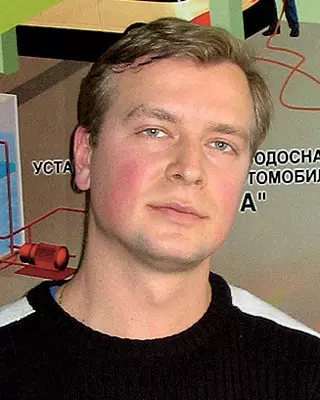
Head of Sales Department CJSC TD "Engineering Equipment":
"In the Russian market there are various attitudes of biological cleaning. When choosing them, it is necessary to pay attention to the following points. First-work unit: according to technological calculations, it should be at least 2.5-3 times of daily performance. The second point concerns the principle, To which the stocks come from the section to the section: Forced (due to the compressor) or gravity (according to the type of vessels). For the case, when the compressor is out of ordering or disconnecting the electricity, the drain movement is not carried out, and if the water supply remains in the house and it is necessary to reset it (Someone takes a bath), then an overwhelming line is overflowing, which leads to the discharge of untreated drains. In the second case, this will not happen, as the drains move sicklet.In the early time, many firms appeared, which took the products of leading companies in the field of wastewater treatment, and, changing the name, produce installations under their name. Such "manufacturers" do not have a technological and constructive calculation of their equipment, as well as operating experience. "
The principle of operation of biological treatment facilities is as follows. For mechanical wastewater treatment, the first chamber is used, which is a so-called septic or methyenk, where in anaerobic conditions (without access of oxygen), fat, weighted particles, floating films are removed from wastewater. We already met the seat process when describing the work of the Septic. The precipitate remains in septic, and the clarified water enters the biological purification unit. It can be represented in three versions: in the form of bio filter, aerotank or their combination.
Biofilter is a compact capacitance with a filling from any porous material: clamzite, shungizitis, puzolane, coke, cape cords, plastic washers. Failure (layer) serves as a place to attach aerobic bacteria breathable by oxygen, with the help of which when air access (through an aeration pipe available in a biofilter), the process of biochemical oxidation of wastewater. Watching 2-3 weeks of operation The layer is covered with a biofilm, which is mucous colonies of microorganisms on the loading material. Biological purification flows in two stages (oxidation - nitrification): First, carbon and hydrogen are oxidized, decaying the carbon dioxide and water, and then the oxidation of nitrogen is carried out at the beginning of nitric acid salts, and then salts of nitric acid and nitrates.
Aerotenk in its functions looks like a biofilter, but in it the structure of the colonies of microorganisms is different. In addition, for the introduction of oxygen and maintaining an active yala in suspension, its mixture with wastewater is aimed (frozen by air). This purpose is used by the pump or compressor. The system becomes much more complicated in operation, since it requires uninterrupted power supply.
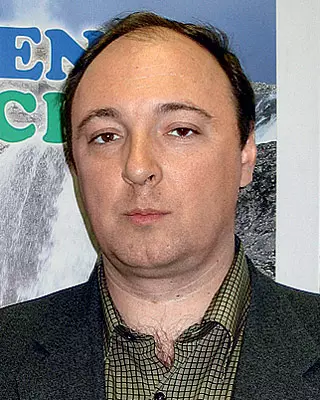
The head of the representative office of Green Rockoy in Russia:
"Talking that aerotanks purify water better than biofilters, it would not be quite right. Biofilters and aerotanks give approximately the same level of wastewater treatment, the difference is that some systems are more efficiently cleaned of them from phosphorus, others From nitrites, thirds of nitrates IT.D. Companies producing devices with biofilters apply various bootable filtering material: Puzolaan, claymzite IDR. We use plastic washers. Thanks to their segmental surface, the area where microorganisms can also have to eat as much as possible. "Organic.The accumulation from biofilters in aerotanks is present a compressor, which pumps oxygen into the chamber, causing the so-called bubble effect. The result is significantly accelerated by the processes of decomposition of microorganisms to a molecular state. But at the same time, the compressor is not only a strong, but also a weak side of these devices. Listening to the failure of the device, incorrect work or long downtime, the system is hired or partial death of existing microorganisms occurs. Devices for cleaning wastewater with biofilters from this are delivered. "
After the second phase of cleaning comes the third stage: deposition-denitrification. The aerated mixture flows into the following container, where the decline of the alley occurs, and nitrates in the anaerobic medium (without access of air oxygen) are converted into gas nitrogen (odorless). Then the surplus is automatically pumped into the septic chamber. ILD, formed during the cleaning process, can be used as a fertilizer for lawn and non-pronomous trees and shrubs (but only after long-term processing of it in the compost ve.). There is a special chlorination chamber in the extraction of biological purification inside the exhaust pipe, which contains a tablet of slow chlorine release. Chlorination, mandatory in front of the drain in the reservoirs and rivers, is intended for disinfection at the output. The disinfaped wastewater enroll in the combustive well, and then the drainage pump set in it is pumped in the terrain relief, in the reservoir, drainage drank, roadside cuvette. That is, after devices of biological purification, it is not necessary to use underground filtration facilities, occupying a large area of the site.
In the Russian market of biological cleaning, Upoclean models are represented by Upoclean models from Uponor (Finland), Green Rock from Green Rock (Finland), Biotal from Biotal (Czech Republic- Russia), as well as products of domestic manufacturers: "Aspen" (Plumbing Research Institute), Topas (Topol-Eco), "Tver" ("Engineering Equipment"), "Cottage Bio" ("League-B"), "Leader" ("Locas"), "Yalma" ("Albatross"), IDR . The cost of installations is $ 2000-3500.
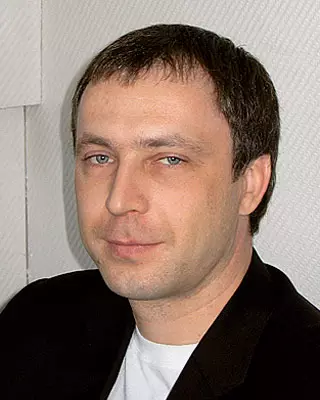
Leader: general director LLC ELITSTROYINVEST:
"The price is definitely one of the most important points when choosing a system of wastewater treatment system. However, it is more correct to be interested in the value of the" turnkey "system, that is, taking into account the installation. Aon can be 2-3 times more expensive than the system itself. For example, the customer is watching the price list and sees that the price of Septica is $ 1500, and biological cleaning systems are $ 2200. Consumer preferences on the side of the septica. Naturally, he wants to receive a system with the installation. Acrief learns that the installation will cost another $ 4000-5000 , I asks a question to employees of the company: why do the septicchka go so expensive?The fact of the matter is that not just bury. Let's consider together. The filtering field is 40m3 of the Earth, died, as a rule, manually (the technique cannot enter or turn around), and plus another 20m3 (in order to cut the trench from the house to the septica and dug the pit for installation). The cost of work is $ 600. The cost of 20m3 rubble required for the filtering field is $ 1300.
Under the septicch, you need to arrange a concrete pillow, attach the tank to it, and then fill the sandy sand with the cement, cover the insulation, another $ 300. The most responsible part is installation: make the right slope of the pipe from the house to the septic tip, install it, put the mortgages IT.D. This is another $ 400. This must be added the cost of pipes, geoticani ($ 300). Next, the crushed stone ($ 400) falls asleep, and behind the numerant ($ 50). Total- $ 3350. The current amount will be installed in the installation of the soil cleaning system. "
Advantages and disadvantages of two types of wastewater treatment devices
So, what kind of drafting schemes is better? It makes no sense to ask such a question, since each of them has both advantages and disadvantages.
The toes of structures with underground filtering of drains can be attributed to the simplicity of the device, the reliability of cleaning, an affordable price, the ability to mount the system independently, full non-volatility. Delicate smell, the need for soil cooking and, as a result, the use of a large area under the filtering field. In addition, the upper layer of filtering structures (wells, trenches) is stipulated over time ("coarse") suspended particles, and therefore in 5-8 years (depending on the intensity of the system use) requires replacement. At the same time, the landscape will be inevitably necessary, and the volume of earthworks will be about 10-15m3. In general, troublesome and expensive, but by virtue of the above positive moments, the system of underground water filtration is popular. There is a modern solution to optimize the septicity with drainage fields - after a sump to install a biofilter.
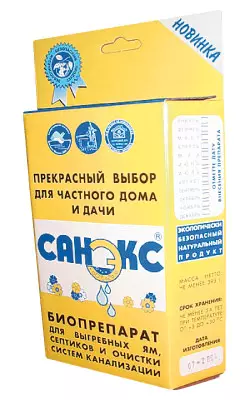
Process accelerators
If you want to accelerate the primary wastewater treatment process 2-3 times, use bioactivators, preparations consisting of a mixture of live microorganisms and enzymes. The bioactivator reduces the amount of solid fractions, fats, fats, toilet paper and phenols in the tank capacity, disintegrating with the preparation on water, gases and precipitate (the latter is suitable for fertilizing the garden). When using bioactivators, the assessing machine will have to be caused more often than three years. "Accelerators" are particularly effective in the following cases: during the first launch of the septica, after its next cleaning and as a means of emergency assistance in the blockage of sewage, overflow or excessive use of household chemicals, destructively affecting biological cleaning processes.Apply bioactivators very simple enough to wash off in the toilet 2 tablespoons of the drug in the toilet, where it comes from the septic tank from the sewer system. In our market there are powder or granules: AtmosBio from ATMOS, Bio 7 Shock and Bio 7G from AB7 Industry (France), Septic System Maintainer DWT-360 (Tri Synergy, USA), Bio Enzyme Granules (Sannitree International, South Africa) . One bank or box with a capacity of 500g and worth 700-750 rubles. Enough for the year for septicity of 4 thousand. l.Consider the advantages and disadvantages of the second type of devices. The use of such installations does not depend on the type of soil and the level of groundwater level, they do not pollute the site, since it does not have to arrange the fields of filtering or absorption, there is no need to call an associate machine, cleaning occurs to 95-98%. At the same time, methane and sulfur gas are not highlighted. But for the action of complete biological cleaning systems, the following conditions are needed: the constancy of the concentration of pollution (that is, the constant composition of the drain), the stability of the volume of wastewater, uninterrupted power supply. The arutor is already explicit cons, as living in the house may not be year-round, interruptions with power supply. The presence of a biofilter that provides a high degree of wastewater purification, of course, an advantage, but in some models it is required to be regularly replaced, which is also a minus. Biological installations of wastewater treatment are primarily the one who lives in a country house constantly. If two or three weeks do not exploit the system, bacteria are dying. You have to buy them, add to the device and wait until microorganisms begin active life.
The list of documents required to obtain permission to accommodate and the construction of individual systems for the waters of objects:
1. Brief description of the designed development: name, administrative position, number of inhabitants, residence regime.
2. Situation area of the area with the object of construction, structures of the drainage system, sanitary protection zones 1: 500.
3. Estimated expenditure of water consumption and drainage with the rationale for the norms.
4. Sewage diagram with type and model of cleaning installation, a technological cleaning scheme, installation performance, degree of cleaning, waste disposal system.
5. Characteristics of the water intake of purified wastewater (for water-category of water use, water characteristics).
The quality of water purified in local sewage treatment facilities (LOS) must meet the requirements of the security authorities. These requirements determine the selection of the type of treatment plant. By purchasing a ready-made wastewater treatment system, be sure to make sure that it has a hygienic conclusion on the products of the CGSEN bodies of Russia. Then you will have problems with the main sanitary doctor of the area, with whom you should agree on the location of the Los and the point of the drain of purified water.
